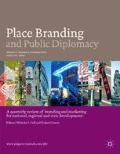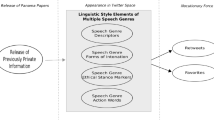Abstract
While national governments increasingly deploy digital diplomacy communication strategies to harness the power of social media, political scientists have paid sparse attention to certain aspects of this development. Our study endeavors to address this lacuna by employing content analysis and data-analytic methodologies to examine U.S. Twitter diplomacy. We leverage a robust dataset of tweets posted by leading foreign policy officials in the Obama administration to determine whether Twitter diplomacy exhibited a coherent communication strategy (per the rational actor model of foreign policy), or a more ad-hoc and disjointed practice (per the pluralist and bureaucratic politics models). Furthermore, this study assesses several variables relating to the efficacy of Twitter statecraft, including the formatting of tweets, and the resonance and geographic reach of tweets. We find that Twitter diplomacy under the Obama administration was largely rational; that is, it reflected the rational actor model, as the topic focus of tweets was proportional to stated U.S. foreign policy priorities.
Similar content being viewed by others
References
Allison, G. 1969. Conceptual models and the Cuban Missile Crises. The American Political Science Review 63 (3): 689–718.
Archetti, C. 2012. The impact of new media on diplomatic practice: An evolutionary model of change. The Hague Journal of Diplomacy 7 (2): 181–206.
Bean, H., and E. Comor. 2017. Data driven public diplomacy: A critical and reflexive assessment. All Azimuth 2017: 1–16.
Bjola, C. 2015a. Digital diplomacy: Theory and practice. New York: Routledge.
Bjola, C. 2015b. Introduction: Making sense of digital diplomacy. In Digital diplomacy: Theory and practice, ed. C. Bjola and M. Holmes, 1–9. New York, NY: Routledge.
Bjola, C., and L. Jiang. 2015. Social media and public diplomacy: A comparative analysis of the digital diplomatic strategies of the EU, US and Japan in China. In Digital diplomacy: Theory and practice, ed. C. Bjola and M. Holmes. London and New York: Routledge.
Bjola, C., and I. Manor. 2018. Revisiting Putnam’s two-level game theory in the digital age: domestic digital diplomacy and the Iran nuclear deal. Cambridge Review of International Affairs 31 (1): 3–32.
Burston-Marsteller. 2017. Twiplomacy study 2017, http://twiplomacy.com/blog/twiplomacy-study-2017/. Accessed 6 June 2018.
Cha, M., Haddadi, H, Benevenuto, F, and Gummadi, K. 2010. Measuring user influence in twitter: The million follower fallacy. In Proceedings of the Fourth International AAAI Conference on Weblogs and Social Media (pp. 10–17).
Clarke, A. 2015. Business as usual? An evolution of British and Canadian digital diplomacy as policy change. In Digital diplomacy theory and practice, ed. C. Bjola and M. Holmes, 111–126. Oxon: Routledge.
Collins, N. and K. Bekenova. 2018. Digital diplomacy: Success at your fingertips. Place Branding and Public Diplomacy (January), 1–11.
Comor, E., and H. Bean. 2012. America’s ‘engagement’ delusion: Critiquing a public diplomacy consensus. International Communication Gazette 74 (3): 203–220.
Council on Foreign Relations. 2001. Improving the U.S. Public Diplomacy Campaign In the War Against Terrorism, 6 November 2001, https://cfrd8-files.cfr.org/sites/default/files/pdf/2001/12/Public_Diplomacy.pdf. Accessed 15 Dec 2018.
Cull, N. 2013. Public diplomacy: Seven lessons for its future from its past. Place Branding and Public Diplomacy 6 (1): 11–17.
Ember, S. 2015. Digital ad spending expected to soon surpass TV. The New York Times, 7 December 2015, https://www.nytimes.com/2015/12/07/business/media/digital-ad-spending-expected-to-soon-surpass-tv.html. Accessed 2 March 2017.
Foreign Affairs. 2015. Obama’s World: Leading experts assess the President’s foreign policy record thus far, in new issue of foreign affairs, Foreign Affairs, 19 August, https://www.foreignaffairs.com/press/2015-08-19/obama-s-world-leading-experts-assess-president-s-foreign-policy-record-thus-far-new. Accessed 28 Jan 2018.
Foreign Affairs. 2018. Website, https://www.foreignaffairs.com/topics/economics?cid=int-gna&pgtype=hpg. Accessed 28 January 2018.
George, A. 1980. Presidential decisionmaking in foreign policy: The effective use of information and advice. Boulder, CO: Westview Press.
Gregory, B. 2008. Public diplomacy: Sunrise of an academic field. The Annals of the American Academy of Political and Social Science 616 (1): 274–290.
Gregory, B. 2011. American public diplomacy: Enduring characteristics, elusive transformation. The Hague Journal of Diplomacy 6 (3–4): 351–372.
Hallams, E. 2010. Digital Diplomacy: The internet, the battle for ideas & U.S. foreign policy. CEU Political Science Journal 4: 538–574.
Hanson, F. 2012. Revolution@ state: The spread of eDiplomacy. Sydney, NSW: Lowy Institute for International Policy.
Harris, B. 2013. Diplomacy 2.0: The future of social media in nation branding. Exchange: The Journal of Public Diplomacy 4 (1): 3.
Hayden, C., D. Waisanesn, and Y. Osipova. 2013. Facilitating the conversation: The 2012 U.S. presidential election and public diplomacy through social media. American Behavioral Scientist 57 (11): 1623–1642.
Hocking, B., and J. Melissen. 2015. Diplomacy in the Digital Age. Netherlands: Clingendael.
Howard, P., and M. Parks. 2012. Social media and political change: Capacity, constraint and consequence. Journal of Communication 62 (2): 359–362.
Internet World Stats. 2018. Internet world stats: Usage and population statistics. http://www.internetworldstats.com/. Accessed 15 Dec 2018.
Kampf, R., I. Manor, and E. Segev. 2015. Digital diplomacy 2.0? A cross-national comparison of public engagement in Facebook and Twitter. The Hague Journal of Diplomacy 10 (4): 331–362.
Khatib, L., W.H. Dutton, and M. Thelwall. 2012. Public diplomacy 2.0: An exploratory case study of the U.S. digital outreach team. The Middle East Journal 66 (3): 453–472.
Leight, N., S. Badawi Walton, T. Ananian, M. Cruz-Enriquez, and K. Jarwaharlal. 2011. PDiN quarterly—trends in public diplomacy: January, February and March 2011. Place Branding and Public Diplomacy 7 (2): 136–149.
Luo, Y., and H. Jiang. 2012. A dialogue with social media experts: Measurement and challenges of social media use in Chinese public relations practice. Global Media Journal 2: 57–74.
Malone, G. 1985. Managing public diplomacy. Washington Quarterly 8 (3): 199–213.
Maher, H. 2018. Leader of the free world: Obama’s 2nd-term foreign-policy priorities. The Atlantic, 7 November, https://www.theatlantic.com/international/archive/2012/11/leader-of-the-free-world-obamas-2nd-term-foreign-policy-priorities/264841/. Accessed 28 Jan 2018.
Manor, I. 2016. Are we there yet: Have MFAs realized the potential of digital diplomacy?. Brill: Leiden.
Manor, Ilan. 2018. Should diplomats dump social media? Digital Diplomacy, dipblog, February 8, 2018. https://digdipblog.com/2018/02/08/should-diplomats-dump-social-media/.
Manor, I. 2018b. The digitalization of diplomacy: Toward clarification of a fractured terminology. Working Paper No 2. Oxford Digital Diplomacy Research Group, January, http://www.qeh.ox.ac.uk/sites/www.odid.ox.ac.uk/files/DigDiploROxWP2.pdf.
Manor, I. and M. Holmes. 2018. Palestine in Hebrew: Overcoming the Limitations of Traditional Diplomacy. Revista Mexicana de Política Exterior 113 (May-August): 163–183.
Manor, I., and E. Segev. 2015. America’s selfie: How the US portrays itself on its social media accounts. Digital Diplomacy: Theory and Practice 2015: 89–108.
Metzgar, E.T. 2012. The medium is not the message: Social media, American public diplomacy & Iran. Global Media Journal-American Edition 11 (21): 1–16.
Metzl, J.F. 2001. Network diplomacy. Georgetown Journal of International Affairs 2 (Winter): 77–87.
Obama, B. 2009. First inaugural address. https://obamawhitehouse.archives.gov/blog/2009/01/21/president-barack-obamas-inaugural-address. Accessed 28 Jan 2018.
Obama, Barack. 2013. Second inaugural address. https://obamawhitehouse.archives.gov/the-press-office/2013/01/21/inaugural-address- president-barack-obama. Accessed 28 Jan 2018.
Obama, Barack. 2015. Tweet. 12 December, https://mobile.twitter.com/POTUS44/status/675812094902714369. Accessed 31 Jan 2018.
Optimizing Engagement: Research, Evaluation, and Learning in Public Diplomacy. 2018. Report by M&C Saatchi for the Advisory Commission on Public Diplomacy (ACPD) at the US Department of State (April).
Pamment, J. 2013. New public diplomacy in the 21st century. London: Routledge.
Pamment, J. 2014. The mediatization of diplomacy. The Hague Journal of Diplomacy 9 (3): 253–280.
Pamment, J. 2015. Digital diplomacy as transmedia engagement: Aligning theories of participatory culture with international advocacy campaigns. New Media & Society 18 (9): 2046–2062.
Parshley, L. 2012. Grading Obama’s foreign policy: Nine experts rate the President’s job so far. Foreign Policy, 24 January 24. http://foreignpolicy.com/2012/01/24/grading-obamas-foreign-policy/. Accessed 5 Feb 2018.
Payne, G., E. Savin, and S. Bruya. 2011. Grassroots 2.0: Public diplomacy in the digital age. Comunicao Publica 6 (10): 45–70.
Pelling, J. 2016. Public diplomacy in the age of networks: Midwives4all. Place Branding and Public Diplomacy 12 (2): 201–209.
Sandre, A. 2013a. ‘Fast Diplomacy’: The Future of Foreign Policy?, Huffington Post, 13 August, https://www.huffingtonpost.com/andreas-sandre/fast-diplomacy_b_3416330.html. Accessed 6 Dec 2018.
Sandre, A. 2013b. Twitter for diplomats. Diplofoundation and Istituto Diplomatico. https://issuu.com/diplo/docs/twitter_for_diplomats. Accessed 1 March 2018.
Sandre, A. 2015. Digital diplomacy. Lanham, MD: Rowman & Littlefield Publishers.
Seib, P. 2012. Real-time diplomacy: Politics and power in the social media era. New York: Palgrave-Macmillan.
Sevin, E. 2017. A multi-layered approach to public diplomacy evaluation: Pathways of connection. Politics & Policy 45 (5): 879–901.
ShareAmerica. 2015. What are President Obama’s foreign policy goals for 2015? https://share.america.gov/president-obamas-foreign-policy-goals/. Accessed 28 Jan 2018.
Slaughter, A. 2009. America’s edge: Power in the networked century. Foreign Affairs 88 (1): 94–113.
Statista. 2018. “Number of monthly active Twitter users worldwide from 1st quarter 2010 to 2nd quarter 2016 (in millions).” http://www.statista.com/statistics/282087/number-of-monthly-active-twitter-users/. Accessed 26 Jan 2018.
Strauß, N., S. van Der Kruikemeier, H. Meulen, and G. van Noort. 2015. Digital diplomacy in GCC countries: Strategic communication of Western embassies on Twitter. Government Information Quarterly 32 (4): 369–379.
Twiplomacy. 2016. Twiplomacy study 2016. http://twiplomacy.com/blog/twiplomacy-study-2016/. Accessed 2 March 2017.
U.S. Embassy and Consulates in India. 2016. Technology, Innovation and American Diplomacy in the 21st Century’—Remarks by Ambassador Verma at Lehigh University. https://in.usembassy.gov/technology-innovation-american-diplomacy-21st-century-remarks-ambassador-verma-lehigh-university/. Accessed 6 Dec 2018.
U.S. Department of State. 2018. “Organization Chart” and “Policy Issues” map. https://www.state.gov/policy/. Accessed 28 Jan 2018.
Yarchi, M., S. Azran, and B. Lidor. 2017. Facebook users’ engagement with Israel’s public diplomacy messages during the 2012 and 2014 military operations in Gaza. Place Branding and Public Diplomacy 13 (4): 360–375.
Yepsen, E. 2012. Practicing successful twitter diplomacy: A model and case study of US efforts in Venezuela. Los Angeles: Figueroa Press.
Zhang, J. 2013. A strategic issue management (SIM) approach to social media use in public diplomacy. American Behavioral Scientist 57 (9): 1312–1331.
Author information
Authors and Affiliations
Corresponding author
Additional information
Publisher's Note
Springer Nature remains neutral with regard to jurisdictional claims in published maps and institutional affiliations.
Appendix
Rights and permissions
About this article
Cite this article
Collins, S.D., DeWitt, J.R. & LeFebvre, R.K. Hashtag diplomacy: twitter as a tool for engaging in public diplomacy and promoting US foreign policy. Place Brand Public Dipl 15, 78–96 (2019). https://doi.org/10.1057/s41254-019-00119-5
Revised:
Published:
Issue Date:
DOI: https://doi.org/10.1057/s41254-019-00119-5





